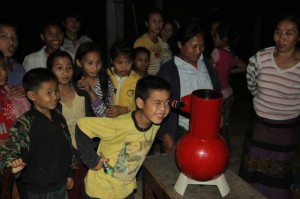Project Phongsali: We must think of creative ways to connect with all villagers.

Both children and adults in the village flock to our camp when we have our telescope out. We use the event as an opportunity to talk with villagers that we might never see during the day.
Day 64
Five years ago Edmond Scientific, a science supply company, donated an “Astroscan Wide Field Telescope” to our project. I appealed for that unusual donation because I guessed that Lao teachers, lacking science books, media or equipment, would be hard-pressed to teach even the most basic concepts of astronomy.
And… I predicted that residents of the remote village I was headed for, while impoverished economically, would possess two resources in abundance: time and darkness. I figured, turn me loose with a telescope in a village with inquisitive children and something significant could happen. It might be just one small step for man. On the other hand, it could be one giant step for mankind.
I can give this endorsement to the Astroscan: it’s a well-built instrument that absorbs abuse and requires no pampering. In fact, it requires no maintenance or recalibration at all. The unit is sealed tight as a drum and after all these years has yet to fall victim to the two elements that most threaten our equipment: dust and humidity.
We are, without a doubt, the only humanitarian bomb clearance project lugging a fire-engine-red, wide-area telescope around the wilds of northern Laos. But, in addition to concern over students’ science education, we had other reasons.
Since most villagers are in their fields from dawn to dusk, we can’t assume that our “risk education” messages reach everyone. Therefore, we must plan activities that will connect us with the people we don’t encounter during daylight hours. Enter…(to the sound of applause, please)… the Astroscan!
Our telescope dependably draws an evening crowd that might otherwise stay home and avoid a sermon on UXO safety. Then, as villagers patiently wait for their turn at the scope, my teammates and I circulate, mingle and schmooze. We talk about the planets, the moon and the stars but, mostly, we chat with villagers about unexploded ordnance.
Other humanitarian organizations draw an evening crowd with movies or music but those activities would require us to talk over background noise, and are practical only in villages blessed with electricity. Our telescope packs the house, requires no electrical power, and permits a lot of side talk.
Last night we drew a larger than usual crowd. It took nearly an hour for everyone to have a turn at the scope (Taking advantage of the darkness, a few enthusiasts snuck back into line for a second peek before others had a first look. (One of the most eager viewers was the head teacher who, on the pretense of helping students, was at the scope repeatedly).
No one here in Sop Houn, not one student, teacher, parent or village elder, had ever before observed the sky through a telescope.
The villagers’ questions indicated how little prior knowledge they brought to the viewing:
“What is the moon made of?”
“Is there water on the moon?”
“Is it hot or cold there?”
“What moves? The moon? The sun? The earth?”
“Where is the sun at night? The moon during the day?”
“Is there wind on the moon?”
“No air? Then, what would you breathe?”
Lao children are very polite. No matter how long their wait for a brief turn at the telescope, they never fail to offer heartfelt words of thanks. As usually happens in my work, I receive credit out of proportion to the contribution I make. For instance, this common refrain: “Thank you for the moon, Mr. Jim”.
